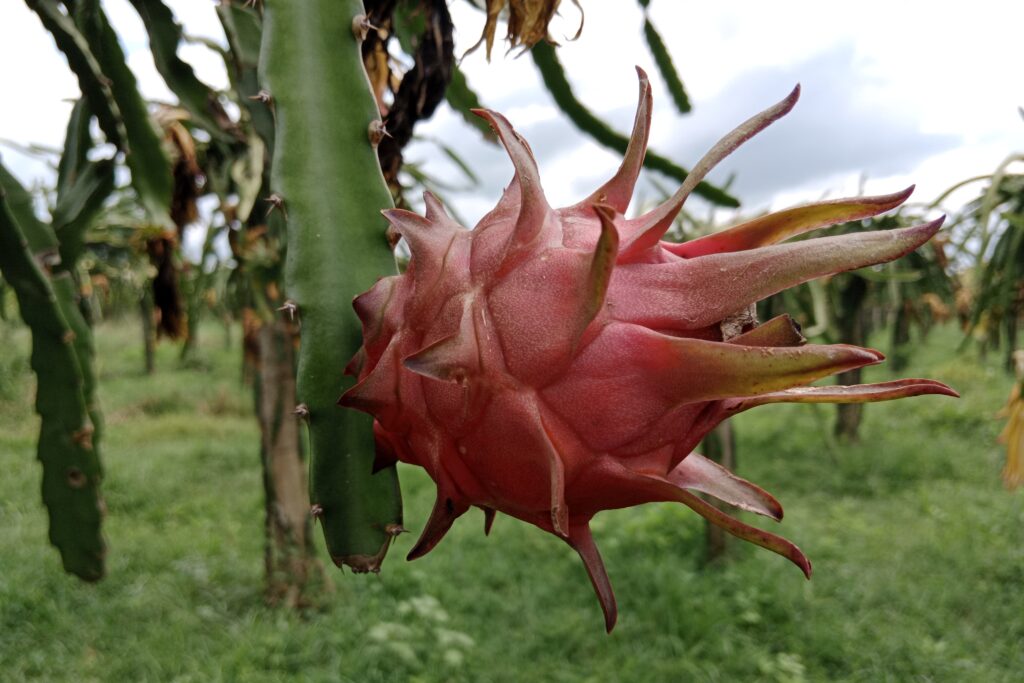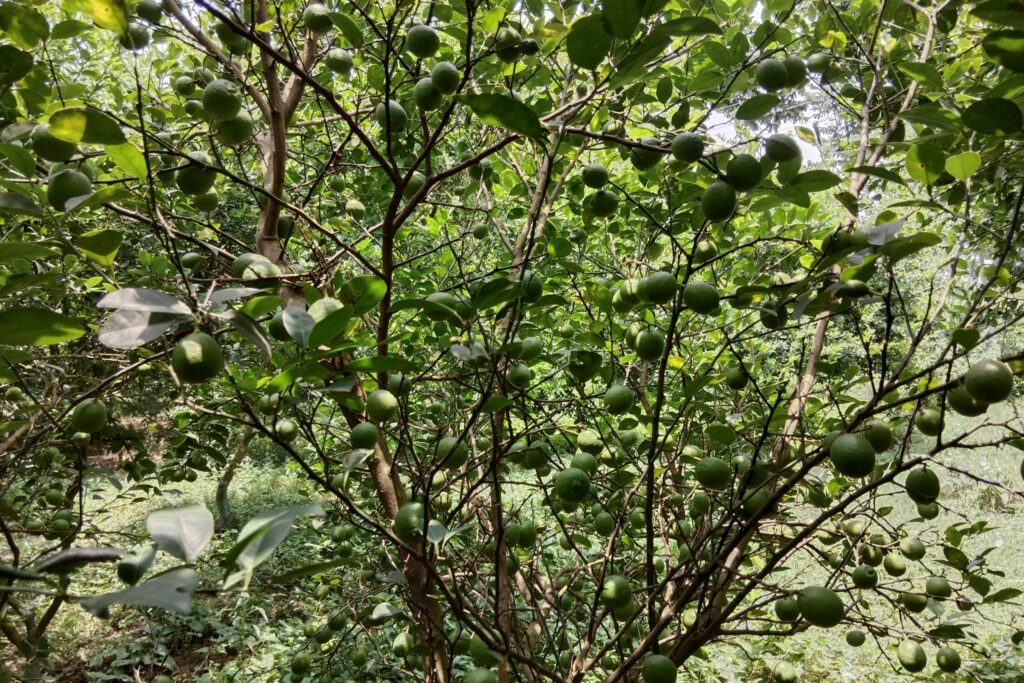Bael Farming
Bael farming profit per acre demonstrates significant potential over a 20-year cultivation cycle, divided into four distinct phases. The Establishment Phase (Years 1–4) incurs initial setup costs of NRs 52,600 in the first year and annual maintenance costs of NRs 37,500 for the next three years, totaling NRs 165,100, with no income generated during this period.
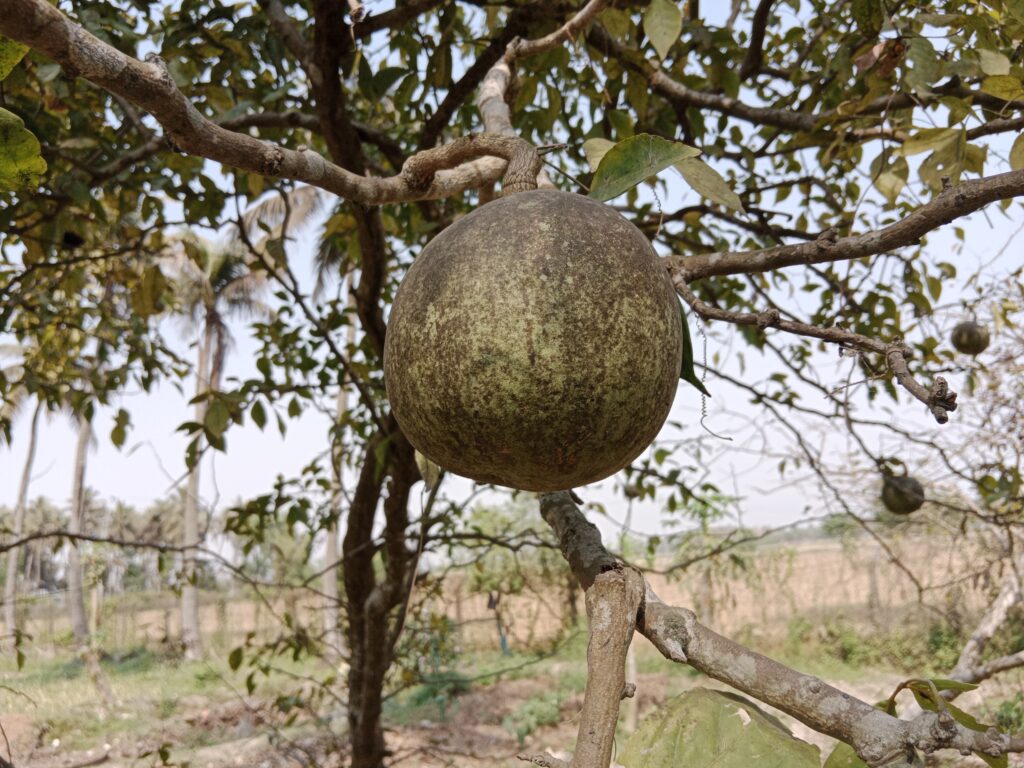
In the Early Production Phase (Years 5–7), income begins at NRs 56,700 annually, resulting in an annual profit of NRs 19,200 after deducting maintenance costs, and a cumulative profit of NRs 57,600 over three years. The Mature Production Phase (Years 8–15) sees a dramatic increase in profitability, with annual incomes of NRs 315,000 and profits of NRs 277,500, accumulating to NRs 2,220,000 over eight years.
The Old Production Phase (Year 16+) maintains steady profits of NRs 277,500 annually due to consistent income and stable maintenance costs. With break-even achieved by Year 8, bael farming offers sustained annual returns of approximately 20% post-establishment, assuming stable yields and market prices, culminating in cumulative profits exceeding NRs 3.5 million over two decades.
Land Preparation
To ensure successful bael tree cultivation, meticulous soil preparation is crucial, starting with removing weeds, rocks, debris, and existing vegetation to minimize competition. The next step involves deep plowing (30–45 cm) to loosen and aerate the soil, improving root access, followed by 2–3 rounds of harrowing to crush clumps and refine soil structure.
Leveling the field is then prioritized to facilitate drainage and prevent water stagnation, safeguarding root health. During pit preparation, integrate 10–15 kg of decomposed farmyard manure or compost per pit to boost soil fertility and nutrient availability. Ideally, complete these steps 2–3 months ahead of the monsoon season, allowing the soil to stabilize and settle, which establishes an optimal foundation for planting bael saplings and fostering vigorous, healthy growth for a productive harvest.
Soil Type
Bael trees thrive in well-drained loamy or sandy loam soils with a pH range of 5.5–8.0, as heavy clay or saline soils can impede growth and root health; ensuring proper drainage is critical to prevent root rot, particularly in regions with high rainfall, where raised beds are recommended to enhance water management and maintain optimal soil conditions for healthy plant development.
Climatic Requirements
The bael tree flourishes in tropical and subtropical regions characterized by hot, dry summers and cool winters. It grows optimally in temperatures of 25–35°C but can endure extreme heat up to 48°C, though it is vulnerable to frost damage. While adaptable to challenging soil conditions, including saline and alkaline substrates, it performs best in well-draining sandy loam soils for commercial cultivation.
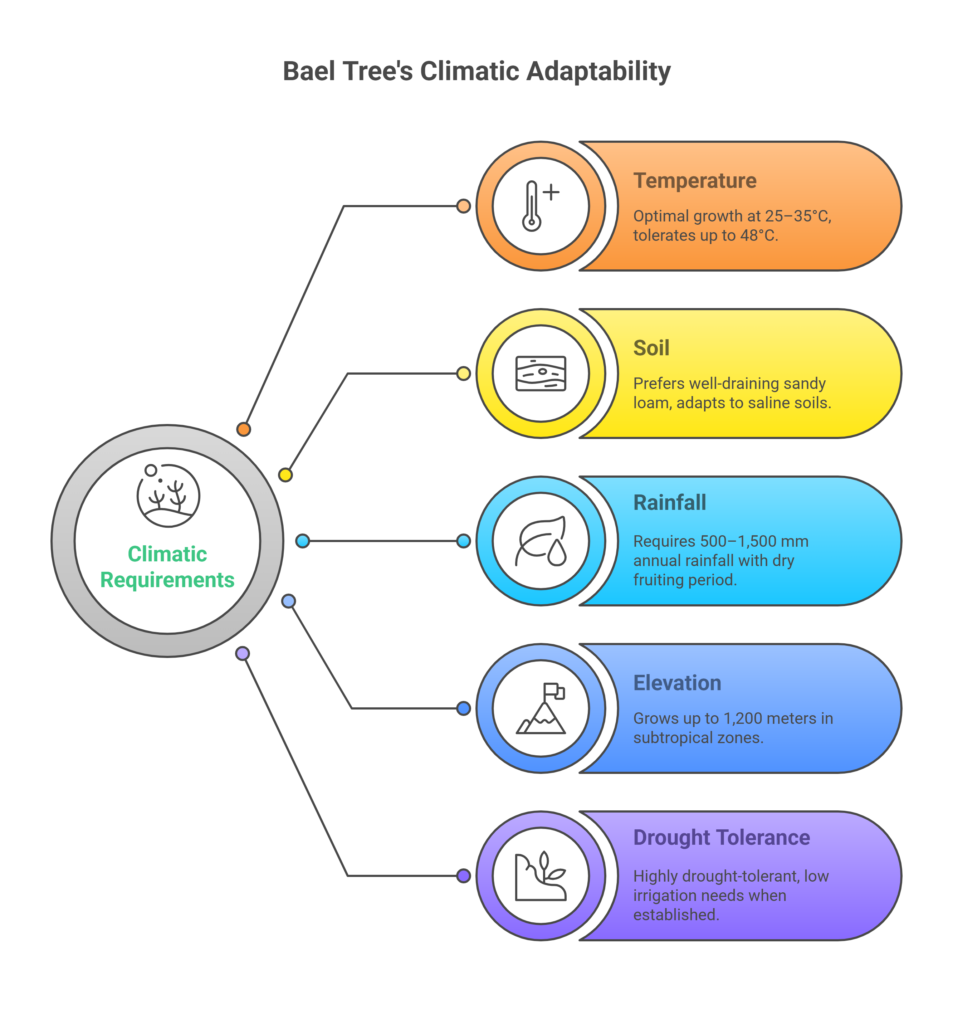
The species requires annual rainfall of 500–1,500 mm, with a pronounced dry period during fruiting stages to enhance fruit development and minimize disease incidence. It thrives at elevations as high as 1,200 meters in subtropical zones and exhibits remarkable hardiness in nutrient-poor soils and harsh climatic conditions. Its drought tolerance and low irrigation demands once established make it a resilient choice for arid and semi-arid agricultural systems.
Major Cultivars
| Variety Name | Key Features | Fruit Description | Tree Characteristics |
| Narendra Bael (NB)-9 | Large, oblong-shaped fruit, low fiber and seed content. | – | – |
| Narendra Bael (NB)-16 | Elliptical round fruit, yellow pulp, low fiber content. | Prolific bearing. | – |
| Narendra Bael (NB)-17 | Average-sized fruit, low fiber content. | Prolific bearer. | – |
| CISH B-1 | Mid-season variety (matures April-May), oval-oblong fruit (1.0kg), dark yellow pulp, good flavor. | – | Mature tree yields 50-80kg. |
| CISH B-2 | Dwarf variety, oblong-oval fruit (1.80-2.70kg), orange-yellow pulp, low fiber/seeds, good taste. | – | Moderately spread; mature tree yields 60-90kg. |
| Goma Yashi | Bigger fruit, yellowish-green color. | Dwarf, spineless, prolific bearer, early maturity. | – |
| Pant Aparna | Globose fruit (~1.0kg). | Dwarf tree, drooping flowers, almost thornless, precocious, heavy bearer. Large dark green pear-shaped leaves. | – |
| Pant Shivani | Fruit weight: 2-2.5kg. | Tall, vigorous, dense upright growth, precocious, heavy bearer. Early mid-season variety. | – |
| Pant Sujata | Fruit weight: 1-1.5kg. | Medium dwarf tree, drooping/spreading foliage, dense, precocious, heavy bearer. | – |
| Pant Urvashi | Mid-season variety, ovoid-oblong fruit (1.5-2.5kg). | Tall, vigorous, dense upright growth, precocious, heavy bearer. | – |
Planting
| Category | Specifications | Details |
| Planting Season | • Tropical: June–July (monsoon onset) • Subtropical: February–March (spring) | Timing aligns with regional climate for optimal sapling establishment. |
| Spacing | 8 m x 8 m between plants | Allows sufficient space for canopy growth and airflow. |
| Pit Preparation | • Size: 1 m³ (1m x 1m x 1m) • Filling: Topsoil + 15–20 kg FYM + 1 kg neem cake + 500g SSP | Ensures nutrient-rich soil and root development support. |
| Planting Method | • Use grafted saplings (budding/patch grafting) • Place sapling centrally, cover with soil, water thoroughly | Grafted saplings ensure early fruiting (3–5 years). Proper planting reduces transplant shock. |
| Plants per Acre | 63 plants/acre | Based on 8m x 8m spacing (1 acre ≈ 4046 sq. m). |
Intercropping
Intercropping, a valuable agroecological strategy, involves cultivating complementary crops simultaneously on the same plot to improve resource efficiency and farm sustainability. In the first 3–4 years after planting, farmers can cultivate legumes (e.g., pigeon pea, green gram), vegetables (e.g., tomato, brinjal), or medicinal plants (e.g., turmeric, ginger) alongside the main crop.
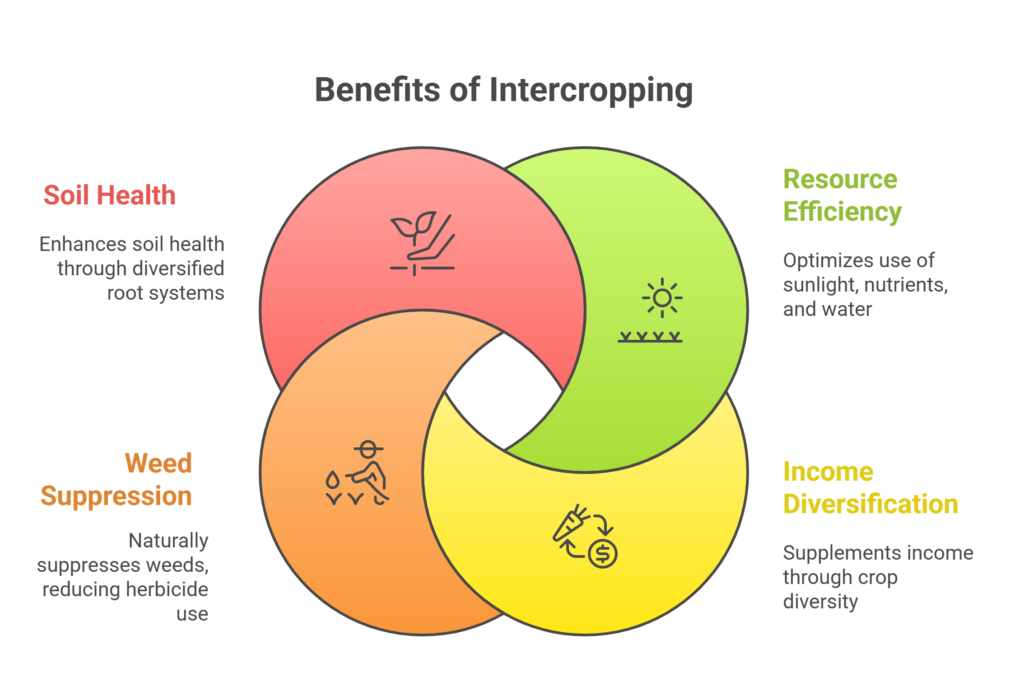
This method optimizes land use by efficiently sharing sunlight, nutrients, and water between crops while supplementing income through crop diversity. Additionally, intercropping suppresses weeds naturally, minimizing herbicide dependency, and fosters soil health through diversified root systems, promoting healthier crops and sustainable farming systems.
Irrigation
Proper irrigation management is crucial for the growth and productivity of plants and trees at different stages of their development. Young plants require weekly watering for the first two years to establish a strong root system, with drip irrigation being an efficient method to conserve water and ensure uniform distribution.
Mature trees, being drought-tolerant, typically need less frequent watering, with irrigation required only during prolonged dry spells, approximately every 3–4 weeks. However, it is essential to provide sufficient water during critical growth stages, particularly during flowering and fruit development, which typically occur between November and March, as adequate moisture during these periods significantly influences yield quality and quantity.
Fertilizer and Manure
It is recommended to apply fertilizers to plants based on soil test reports to ensure a balanced nutrient supply and prevent over-fertilization.
| Fertilizer Type | Application Stage | Quantity per Plant | Timing | Notes |
| Basal Dose | At planting | 10–15 kg FYM + 500g SSP 50g Trichoderma viridae | During pit preparation | Mix with soil to enrich nutrients. |
| Annual Application | Year 1–3 | 50g N, 25g P, 50g K | Split into 2 doses: | Apply half in June (pre-monsoon) and half in September (post-monsoon). |
| Year 4+ | 500g N, 250g P, 500g K | Split into 2 doses: | Adjust based on tree health and soil fertility. | |
| Foliar Sprays | Deficiency correction | 0.5% zinc sulfate or borax (as needed) | During active growth phases | Apply 2–3 sprays per year to address micronutrient deficiencies. |
Weed Control
In order to safeguard the trees, bael cultivation employs a combination of human weeding, mulching, and the cautious application of herbicides such as glyphosate, which should only be used outside of the root zones. Strict adherence to suggested dosages and application techniques reduces the negative effects on the environment. To prevent weeds, retain soil moisture, and improve soil health, organic mulch—such as straw or dried leaves—is spread around the base of trees. In order to promote robust early growth and lessen competition for nutrients and water, young plants require regular hand weed removal.
Pest and Disease Management
Common Pests
a). Fruit Fly
Fruit fly infestations in bael cultivation can be effectively managed through an integrated approach combining pheromone traps and neem oil sprays: pheromone traps are strategically placed in orchards (4–5 traps/acre) to lure and trap male flies, disrupting their mating cycle and reducing population growth, while neem oil sprays (2–3% concentration) applied during the fruit development stage act as a natural repellent, deterring female flies from laying eggs on fruits and inhibiting larval development, thus minimizing fruit damage and ensuring healthier yields with minimal reliance on synthetic chemicals.
b). Stem Borer:
To manage stem borer infestations in bael plants, a targeted approach involves injecting kerosene emulsion into active borer holes: first, identify fresh entry points marked by frass (sawdust-like excreta) on stems, then prepare a diluted kerosene-water emulsion (1:4 ratio) and carefully inject it using a syringe or narrow nozzle into the tunnels to suffocate and kill larvae and pupae; after treatment, seal the holes with clay or mud to prevent re-infestation, while ensuring minimal use of kerosene to avoid phytotoxicity, and complement this method with regular monitoring and removal of severely infested branches to maintain plant health and reduce pest populations effectively.
c). Leaf Miner
Leaf miner infestations in bael plants, caused by larvae tunneling into leaf tissues and creating visible serpentine trails or blotches, can be managed through a dual approach: physically removing affected leaves and applying targeted insecticides. Begin by inspecting the foliage for signs of mining activity (discolored, distorted, or blistered leaves) and promptly prune and destroy infested leaves to disrupt the pest’s lifecycle and prevent further spread.
For severe infestations, spray imidacloprid (a systemic insecticide) at a dilution of 0.5–1 ml per liter of water, ensuring thorough coverage of both upper and lower leaf surfaces; this chemical is absorbed by the plant, effectively killing larvae and adults upon ingestion while minimizing harm to beneficial insects. To optimize results, combine this with regular monitoring, proper sanitation (clearing leaf debris), and organic alternatives like neem oil for early-stage infestations, ensuring minimal environmental impact and sustained plant health.
d). Bael Butterfly
The lime butterfly, or Papilio demoleus, is the source of the pest problem in question. It can harm nursery seedlings by consuming delicate leaves and impairing plant health. A biologically derived insecticide called Spinosad must be used at a concentration of 60 milliliters per recommended water volume for effective management. To guarantee complete control of the insect population and to safeguard the seedlings during their crucial growth stage, the spray should be administered every eight days. To optimize effectiveness and stop insect recurrence, regular monitoring and appropriate treatment methods are crucial.
e). Leaf eating caterpillars
Leaf-eating caterpillars pose a significant threat to bael plants, particularly during the emergence of new foliage, as they voraciously feed on tender leaves, leading to defoliation, reduced photosynthesis, and stunted growth. To control infestations, apply Thiodan (endosulfan) at a concentration of 0.1% by thoroughly spraying the solution on both upper and lower leaf surfaces, ensuring coverage during early infestation stages.
For optimal results, combine chemical treatment with manual removal of visibly damaged leaves and larvae, and repeat applications at 10–15 day intervals if necessary. Due to environmental and safety concerns associated with chemical insecticides, prioritize integrated pest management (IPM) strategies such as introducing natural predators (e.g., parasitic wasps) or using neem-based biopesticides as alternatives. Always adhere to safety guidelines, including protective gear and pre-harvest intervals, to mitigate risks to pollinators, soil health, and human safety.
Common Diseases
a). Fruit cracking and fruit drop
Fruit cracking and fruit drop, two critical physiological disorders affecting bael plants, arise from factors such as irregular moisture levels, nutrient imbalances (particularly boron deficiency), and environmental stress, leading to weakened cell structure in developing fruits and premature shedding.
To mitigate these issues, a targeted application of borax (sodium borate) at 0.1% concentration is recommended: the first spray during the full bloom stage strengthens flower retention and initial fruit formation by enhancing pollen viability and cell wall integrity, while the second application after fruit set ensures sustained boron availability, improving calcium uptake and reducing susceptibility to cracking caused by rapid fruit expansion or water fluctuations.
This dual-treatment approach addresses boron deficiency, stabilizes fruit development, and minimizes drop by reinforcing the fruit’s attachment to the stem, ultimately enhancing yield quality and quantity. Regular monitoring and adherence to dosage are crucial to avoid overuse and maintain soil health.
b). Sooty mould
Sooty mould, a fungal disease in bael plants, appears as a black, powdery layer on leaves and stems, typically developing due to sap-sucking insects like aphids or scales that secrete honeydew, which fosters fungal growth.
Effective management involves spraying a mixture of 0.2% wettable sulphur (to eliminate the mould), 0.1% chlorpyriphos or methyl parathion (to target the insects causing honeydew), and 0.3% gum acacia (to improve adherence). Ensure thorough coverage of affected foliage, including both upper and lower leaf surfaces, and repeat the spray every 10–15 days until the problem resolves.
To prevent phytotoxicity, spray in the early morning or late evening, and incorporate pest management strategies like pruning infested branches or introducing natural predators such as ladybugs to reduce dependence on chemical treatments, promoting sustainable plant health and environmental care.
Harvesting
Bael fruits reach maturity within 8–9 months, indicated by a yellow-green color on the rind. At full maturity, a single tree can yield 200–300 fruits annually, translating to a productivity of 10–15 tonnes per acre. Harvesting is done manually using clippers to ensure the fruits are not dropped or bruised, preserving their quality. Post-harvest, fruits should be stored in cool, dry places to maintain freshness. They typically ripen within 1–2 weeks after harvesting and have a shelf life of 2–3 months, making them suitable for both immediate consumption and longer storage or transport.
Cost of Investment per acre for Bael Farming
| S.N. | Category | Cost (NRs) |
| 1 | Land Preparation | 15,000 |
| 2 | Plant Saplings | 12,600 |
| 3 | Labor (Transplanting) | 2,000 |
| 4 | Fertilizers & Manure | 4,000 |
| 5 | Irrigation | 2,000 |
| 6 | Weed Control | 5,000 |
| 7 | Pest & Disease Control | 4,000 |
| 9 | Miscellaneous Costs | 8,000 |
| Total Initial Cost | 52,600 |
Annual maintenance cost for Bael Farming
The annual maintenance cost for Bael farming from the second-year onward ranges between NRs 25,000 to 50,000 per acre, encompassing recurring expenses such as fertilizers, organic manure, pest and disease management, irrigation, labor for pruning and weeding, and periodic soil health monitoring.
This variability in costs depends on factors like regional labor rates, pest pressure, irrigation infrastructure efficiency, and the use of organic versus chemical inputs. For simplified financial projections, an average of NRs 37,500 per acre is often used, balancing potential fluctuations and ensuring a realistic estimate for long-term planning.
These costs are critical to sustaining tree health and productivity, particularly during the pre-fruiting phase (Years 2–4), and remain essential even as the orchard matures to maximize yield and fruit quality.
Income from per acre bael farming
| Tree Age | Fruits/Tree | Total Fruits/Acre | Price/Piece (NRs) | Total Income (NRs) |
| 5–7 Years | 30 | 1,890 | 30 | 56,700 |
| 8–15 Years | 125 | 7,875 | 40 | 315,000 |
| 16+ Years | 100 | 6,300 | 50 | 315,000 |
Analysis of Bael Farming Profit Per Acre
A). Profit Analysis
a). Establishment Phase (Years 1–4)
Year 1: Total cost = NRs 52,600 (initial setup).
Years 2–4: Annual maintenance = NRs 37,500/year (total = NRs 112,500).
Total Cost (Years 1–4): NRs 165,100
Income: NRs 0 (no harvest during this phase).
b). Early Production Phase (Years 5–7)
Annual Income: NRs 56,700
Annual Maintenance: NRs 37,500
Annual Profit: NRs 19,200
Total Profit (3 years): NRs 57,600
c). Mature Production Phase (Years 8–15)
Annual Income: NRs 315,000
Annual Maintenance: NRs 37,500
Annual Profit: NRs 277,500
Total Profit (8 years): NRs 2,220,000
d). Old Production Phase (Year 16+)
Annual Income: NRs 315,000
Annual Maintenance: NRs 37,500
Annual Profit: NRs 277,500
B). Cumulative Profit Over 20 Years
| Phase | Years | Total Profit (NRs) |
| Establishment | 1–4 | -165,100 (loss) |
| Early Production | 5–7 | +57,600 |
| Mature Production | 8–15 | +2,220,000 |
| Old Production | 16–20 | +1,387,500 |
| Net Profit | 20 | NRs 3,500,000 |
The profit analysis of Bael farming reveals four distinct phases. 1. Establishment Phase (Years 1–4) incurs an initial setup cost of NRs 52,600 in Year 1, followed by annual maintenance costs of NRs 37,500/year for Years 2–4 (total NRs 112,500), resulting in a cumulative loss of NRs 165,100 with no income during this period.
2. Early Production Phase (Years 5–7) generates an annual income of NRs 56,700 against maintenance costs of NRs 37,500, yielding a modest annual profit of NRs 19,200 and a total 3-year profit of NRs 57,600.
3. Mature Production Phase (Years 8–15) sees a significant income surge to NRs 315,000/year, with annual profits of NRs 277,500 after deducting maintenance costs, accumulating NRs 2,220,000 over 8 years.
4. Old Production Phase (Year 16+) maintains stable annual profits of NRs 277,500 due to consistent income (NRs 315,000) and steady maintenance costs (NRs 37,500). Over a 20-year span, cumulative profits exceed NRs 3.5 million, with break-even achieved by Year 8 and sustained annual returns of ~20% post-establishment, assuming stable yields and market prices.

